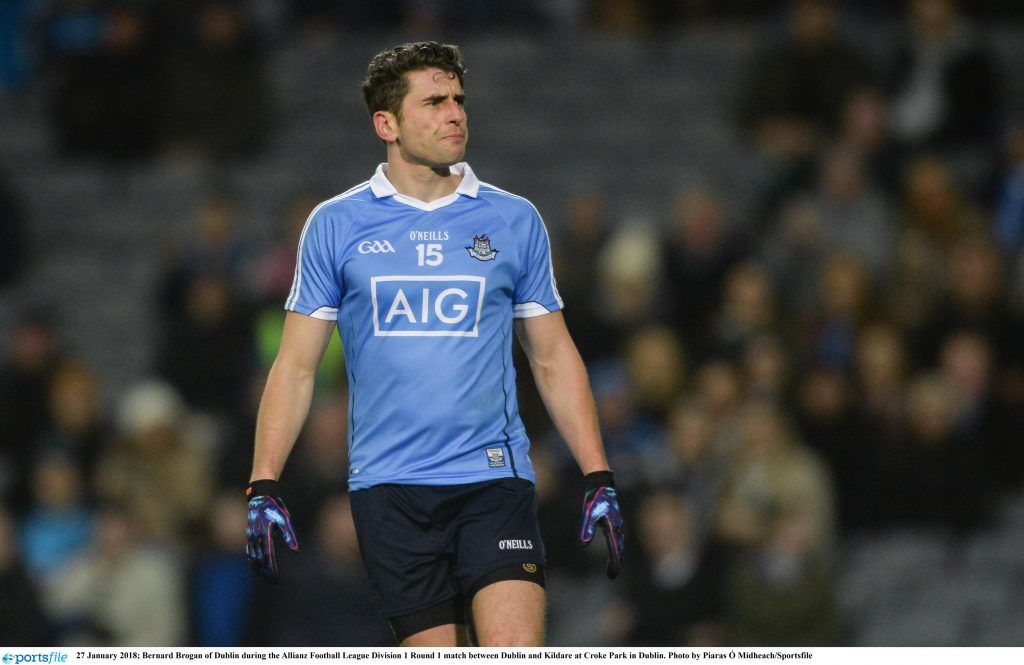The veteran forward may miss the rest of the season after injuring his cruciate ligament.
It’s hard not to feel bad for Bernard Brogan. Considering the 33-year-old has been known to work on his fitness while his Dublin team-mates holiday in South Africa, it felt like a particularly crushing blow when news broke that he had injured his cruciate ligament in training.
The dreaded ACL injury. It’s always a long road back after doing your ACL. Brogan knows that road as well as anyone, having missed the 2004 season with the same injury.
However, while the rehabilitation process will be undoubtedly gruelling, it is not necessarily the death knell on Brogan’s brilliant inter-county career, one that has produced five All-Ireland titles, 11 Leinster championships and a Footballer of the Year award in 2010.
Brogan, it seems, has two options. He can opt to undergo surgery, a decision which will see him out of the game for anywhere between six to 12 months.
Reports emerged this morning about an injury he sustained in training last week https://t.co/Ps2vCXOaAB
— SportsJOE (@SportsJOEdotie) February 12, 2018
However, he can undertake a slightly more radical recuperation programme: skip surgery and gradually rebuild the muscle to the point where he can return.
The latter is ostensibly appealing. Instead of several months out, Brogan could focus on low-impact work and be back playing within the next two months. The risk attached, however, is significant. Of course, if he feels as though this season represents his last chance to feature prominently in Jim Gavin’s Dublin side, it may persuade him to explore the surgery-less option.
To get a more nuanced grasp on the severity of the injury, and indeed the risks involved with opting to skip surgery, SportsJOE asked injury expert Eamon O’Reilly, who has worked closely with the Dublin hurling team in the past.
“There are many determining factors that will go into making a decision regarding ACL surgery vs conservative rehab: the athlete’s age, their sport, their level of activity and their goals in their given sport,” he said.
“In Bernard’s case, he is looking to return to a high-level, high-intensity multidirectional sport that involves a lot of twisting/turning and pivoting. All of these require massive control of your knee joint and the ACL provides stability around the knee joint in all these movements.
“There are other components that make up the stability of the joint with muscle control being a key part of this. If you are going to try a conservative route building up the quadriceps and, in particular, the hamstring muscle groups will be vital.
“The rehab would then focus on other areas such as landing/jumping control, and multidirectional running mechanics. Even doing all of this, there would be absolutely no guarantee that his knee wouldn’t give way going for the first ball when he returns to competitive training.
O’Reilly argues that it’s far from inconceivable for Brogan to return without having had the surgery. At this stage, we do not know if his injury is a partial tear or a total rupture – a major factor in determining his next course of action.
“There have been high profile cases where people have successfully played with no anterior cruciate ligament but these are in the minority rather than the majority. The lack of stability means that often the knee will give way again on return to play when the athlete returns to the type of movements that the ACL provides stability in.
“We saw this with Henry Shefflin in the 2010 All Ireland final. One of the big questions around Bernard’s case is whether it is a total rupture or a partial tear and whether there is more damage around the joint (cartilage/other ligaments) and it is often the case that there is extra damage.
“A partial tear would increase his chances of returning with a rehab only approach whereas a complete rupture is much tougher. There is also risk of doing more damage to the joint itself if it is unstable and you try to continue to play on it.
“It is a huge ask to return to inter-county level after an ACL rupture without surgery and, in most cases, going for an ACL reconstruction represents the best option to return athletes to play with the least amount of risk of future injury. Bernard may be weighing up whether he has another year in him after this year or whether he will roll dice with rehab only to make it back for the summer this year.
“One thing you can be sure is that Bernard will want to finish his career on his own terms and won’t let injury dictate those to him.”
Although this injury represents a major setback at an interesting time in Brogan’s career, the curtain has not yet been drawn. What Brogan now faces is a huge decision, one that, if things go wrong, could result in a whimpering end to what has been a fantastic football career.































